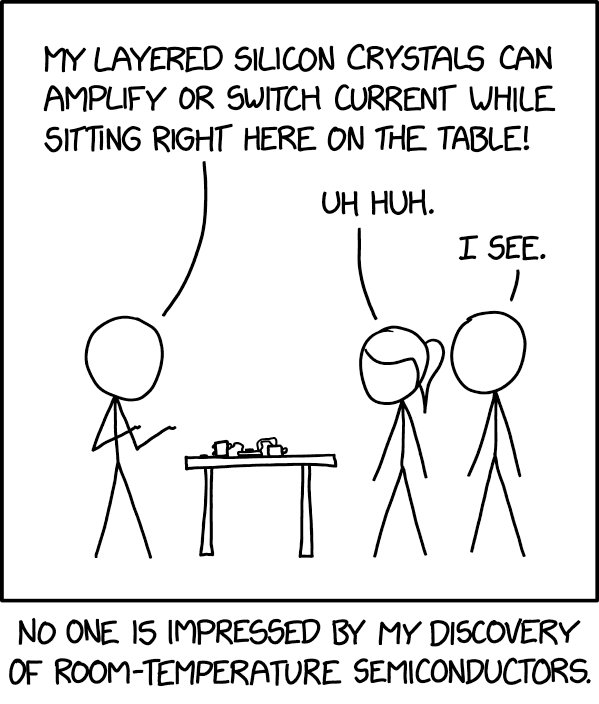"Accomplished by a team at the Huazhong University of Science and Technology and posted 30 minutes ago.
Why this is evidence: The LK-99 flake slightly levitates for both orientations of the magnetic field, meaning it is not simply a magnetized piece of iron or similar ‘magnetic material’. A simple magnetic flake would be attracted to one polarity of the strong magnet, and repelled by the other. A diamagnet would be repelled under either orientation, since it resists and expels all fields regardless of the polarity.
Caveats There is no way to verify the orientation of the strong magnet in this video, also, there are yet to be published experimental measured values of this sample. Diamagnetism is a property of superconductors but without measured and verified data, this is just suggestive of a result.
Take-away If this synthesis was indeed successful, then this material is easy enough to be made by labs other than the original research team. I would watch carefully for results out of Argonne National Lab, who are reported to be working on their own synthesis of a sample.
This overall corroborates two independent simulation studies that investigated the original Korean authors claim about material and crystal structure, and both studies supported the claims.
Lawrence Berkeley National Lab: https://arxiv.org/pdf/2307.16892.pdf Shenyang National Lab: https://arxiv.org/pdf/2307.16040.pdf "
Why can’t an independent researcher just go over to the lab of the original authors with a magnet and some equipment, to verify the measurements on their sample? Why are we forced to squint at blurry Bilibili videos?
Why should they? If they can reproduce LK-99, this is no longer necessary. If the case was that no-one could replicate it, but the original lab still insists, then such an investigation might make sense, either to verify them, or to find further information.
Replicating an experiment is not always easy, because it can always be that the original publisher did not provide all information. That could be on purpose, or just by accident, because there is e.g. something they don’t know. Like in one case where a lab had some interesting results, and in the end it turned out that one of the ingredients were of insufficient purity.
In this case its quite simple: the production process is cheap and easy enough anyone with a garage can replicate it in a week, where as flying to Korea takes weeks for visa and plane ticket and appointments scheduling
Considering the two studies which claim that no effect was observed, I believe the original authors observed the effect but they don’t fully understand the origin.
The original paper is so naively unprofessional in some places that it is really hard for me to think it is not genuine.
My first reaction to this comment was “yeah, but the quality of the paper has nothing to do with whether or not it is true”.
On second thought, I’m not sure about that. I mean, a low quality paper isn’t a good signal, but on the other hand, the presentation of an argument doesn’t change whether or not it’s true.
At least we know there are other labs trying to replicate, we already have rumors of some replications.
My point was that if they would be trying to forge the results, they would likely write a better paper. Like, I have never seen nor would I use a phrase like:
Humankind has long learned that the properties of matter stem from its structure.or
It is the superconductor with the same color as typical superconductors.in the results section. It just reads like a student report.
So while it does not prove whether it is correct or not, it, at least in my understanding, indicates that it is genuine. The explanation might be off, the important step of the synthesis might include adding a teaspoon of luck, but the observations/measurements part I believe. Which is what I meant by the comment.
This is quite a counterclaim over that group who published that they could not replicate the effect. Lets see what happens next.
Can someone explain in lay terms why this is relevant? I read somewhere that it was considered as important as the invention of the transistor but didn’t catch why.
Superconductors in general have no electrical resistance. That’s basically electricity’s friction.
Superconducting materials make the strongest electromagnets, they have big applications in quantum stuff (which I don’t properly understand to try explaining), and they’re used in something called a Tokamak, a specific kind of fusion reactor. They’re useful in anything where electrical resistance is bad in general. When electricity is resisted, we lose some and get heat, so a superconducting wire would lose none and never heat up as a result of resistance.
Superconductors traditionally have to be super freaking cold. A lot of these applications can only be done with liquid nitrogen or even colder things, keeping them superconducting. You can do some things with pressure to help out with that, but the point is it’s not easy to keep a material superconducting. This effort translates to costs, often prohibitive ones, as you need to actively keep these materials from collecting any heat.
If this research pans out, though, this kind of superconductor will just work at standard temperature and pressure. These could go into standard circuits, they can sit around without bleeding money on upkeep, they’re very cool.
People are comparing them to transistors in part because before transistors we had vacuum tubes. Vacuum tubes do the same thing as a transistor, but they’re effectively a lightbulb. They burn out, they produce heat, and they didn’t miniaturize. Transistors were magic at the time because we could do so much more with them than vacuum tubes, and for superconducting metals, this is the same.
Thanks for the explanation. So, this means we are another step closer to quantum computers for example?
I’m trying to grasp on this concept and how we could see this in our daily lives. Better batteries? I thought about that because they get hot when charging but not sure if it’s because of the resistance. Going into standard circuits means we’ll have better SoCs? better integrated circuits? Faster computers or phones?
Im trying to think about a daily life application but maybe it won’t have a direct impact on that area, maybe it’s more about facilitating research that will eventually turn into daily life stuff?
Better batteries, yeah. That’s down the line. We will also generate heat during the actual use of any devices. But, less.
It also could become the most efficient commercial batteries, but I expect the cost will be prohibitive. Sending electricity always has a loss, but it doesn’t through a superconductor, so these will have a lot of uses at power generation sites, both reducing heat and losslessly storing it (until it enters the traditional grid).
It won’t directly transfer to faster tech or anything like that, but it helping quantum computing could do so indirectly.
Definitely it’s more of a facilitating research kinda thing. You can’t play with superconductors in a lab in a cost efficient way, but this could let you.
Also maglevs and MRI’s directly use superconductors currently, so that’s a direct use, lower cost MRI’s and incredibly fast trains.
Got it. So it’ll eventually lead to develop or improve daily stuff. I hope this material becomes a reality.
One thing that you’ll definitely observe in daily life is the development of fusion reactors. They’re significantly safer than regular nuclear reactors (which run on fission), and also a lot cheaper (theoretically). The current downside to fusion reactors is that up until this point, it usually takes up more energy to run it than the energy that gets produced. So in other words, it doesn’t actually generate enough energy to make it worth building. Most of the energy spent is trying to keep the magnets in the reactor cold enough to function. Since room temperature superconductors should function at room temperature, there will be no need to keep them cold, so a lot of the energy spent keeping the magnets cold will become unnecessary. This will significantly improve the development of fusion reactors, to the point where it is possible that we may even see fusion reactors on our energy grid in our lifetimes. Basically, if this claim is true, you can expect that energy costs will become virtually negligible and the world will almost completely run on renewable energy
Well I really hope this is real then and more importantly it translates to cheap, clean energy
I think it’ll be first used in energy transmission.
If it’s actually a thing.
Let him cook
ELI5 for those of us without quantum physics degrees?




